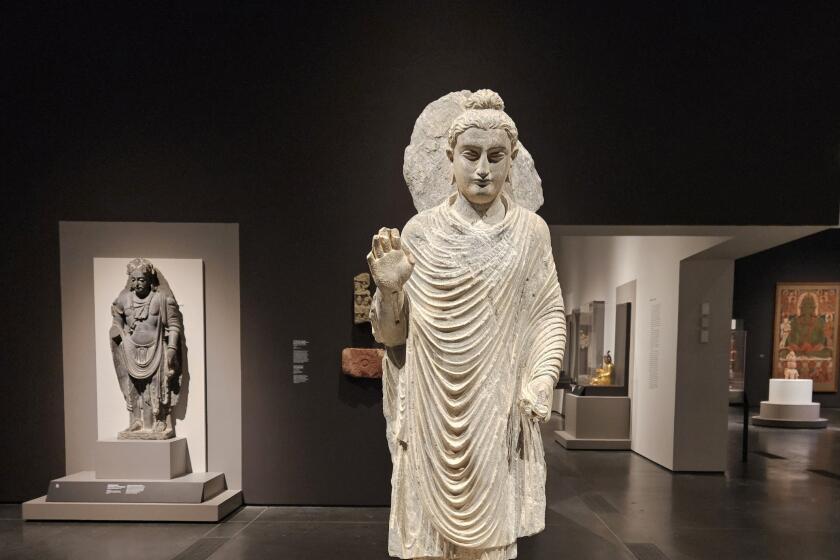LACMA's Hidden Buddhist Masterpieces Unveiled

A Journey Through Buddhist Art in “Realms of the Dharma”
“Realms of the Dharma: Buddhist Art Across Asia” is a remarkable exhibition that showcases some of the most exquisite sculptures and paintings from the permanent collection of the Los Angeles County Museum of Art. This display offers a rare opportunity to witness these works, which have been absent from public view for nearly a decade.
The majority of the art was removed around eight years ago as part of preparations for the demolition of the museum’s original campus and the construction of a new building for the permanent collection. The current exhibition, featuring approximately 180 objects, was originally displayed in 2018 at Mexico City’s National Museum of Anthropology. Subsequent plans for the tour to Texas and the Pacific Northwest were disrupted by the pandemic, leading to the artwork being placed back into storage. Now, it has returned to the Resnick Pavilion, offering a fresh perspective on these cultural treasures.
Siddhartha Gautama, widely recognized as the historical figure Shakyamuni Buddha, lived in India around the 5th century BCE. Early representations of the Buddha were abstract symbols, such as a starburst within a spiraling whorl, symbolizing light within an eternal flow. Over time, these depictions evolved, incorporating elements like the Bodhi tree or footprints to signify enlightenment and spiritual journey.
As Buddhism spread across South and Southeast Asia, it encountered various cultures, leading to the development of diverse artistic expressions. In China, for instance, the Buddha was often depicted as a regal figure, while in Kashmir, he appeared in intricate metalwork. These variations highlight the adaptability of Buddhist iconography, reflecting local traditions and beliefs.
One standout piece is an 8th-century brass and silver cast from Kashmir, depicting the Buddha seated with crossed legs and fingers entwined. Another notable work is a life-size columnar figure from the Gandhara region, showcasing the influence of Greco-Roman art through its detailed drapery.
Symbolic hand gestures, known as mudras, are also prevalent in Buddhist art. A Burmese Buddha, for example, raises an oversized right hand in a gesture of peace, while his left hand appears to be in motion. These gestures convey deep spiritual meanings and are integral to understanding the context of the artworks.
Ritual tools, such as a jewel-encrusted crown and ceremonial knives, accompany the religious artifacts. An offering cabinet adorned with paintings of fierce demons serves as a reminder of the sacredness of the items it contains. These objects not only enhance the visual appeal but also provide insight into the practices and beliefs associated with Buddhism.
The exhibition also features sculptures and paintings of poets, lamas, deities, and bodhisattvas—earthly helpers who delay their own entry into nirvana to assist others. These figures often exhibit elaborate forms, with multiple arms and heads, reflecting the complexity of Buddhist cosmology.
A striking 15th-century painting on cotton cloth depicts a fiery scene of sexual coupling between deities, illustrating the dynamic and often intense nature of Buddhist symbolism. The composition captures the essence of divine union, emphasizing themes of compassion and wisdom.
The installation of “Realms of the Dharma” follows a straightforward approach, beginning with an introduction to Siddhartha Gautama and outlining basic Buddhist principles. Objects are grouped by chronology and region, a common method for museum collections. However, the upcoming David Geffen Galleries will shift toward thematic displays, highlighting the evolving nature of art curation.
While the exhibition serves as an educational resource, it also raises important questions about the ownership and provenance of the artworks. Some pieces, such as a 15th-century painting from Nepal, have been contested as stolen. Acknowledging these issues could add depth to the visitor experience and foster a more nuanced understanding of the collection.
“Realms of the Dharma” will remain on view until July 2026, providing ample time for visitors to explore this rich collection. As the new Geffen building prepares to open, the exhibition stands as a testament to the enduring legacy of Buddhist art and its significance in the cultural landscape of Los Angeles.
Post a Comment for "LACMA's Hidden Buddhist Masterpieces Unveiled"
Post a Comment